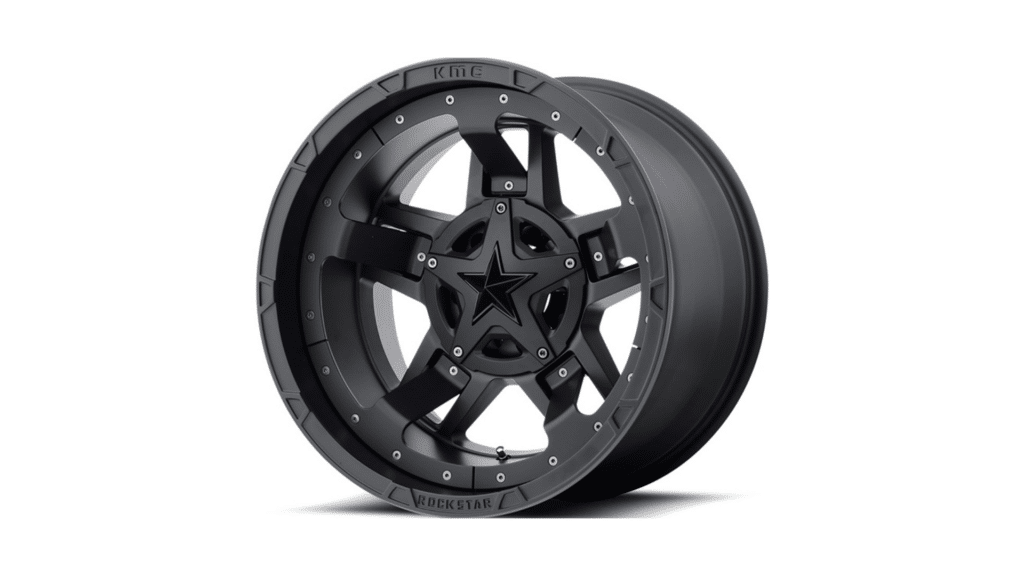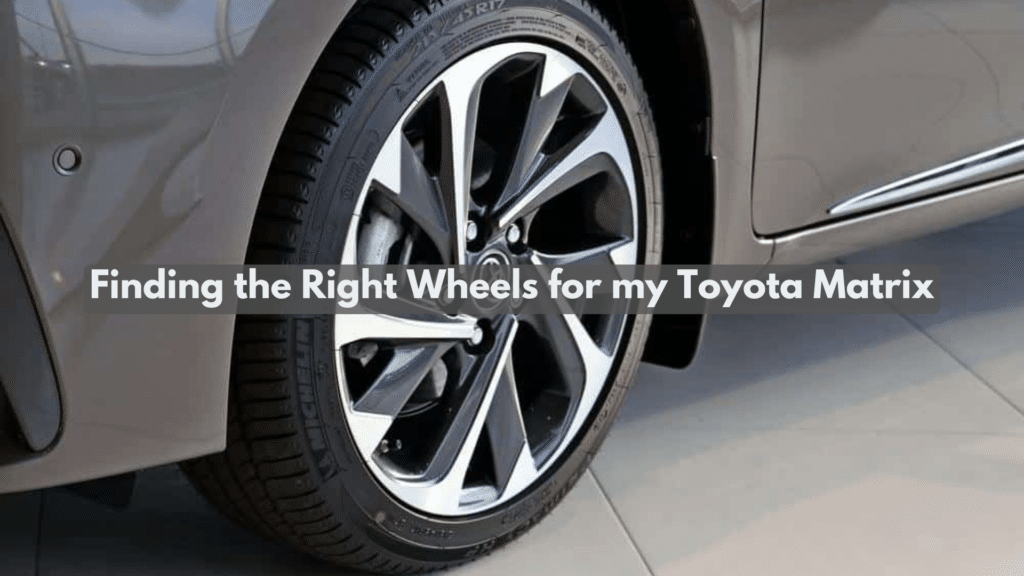Finding the right wheels for your Toyota Matrix doesn’t have to be a headache. I’ve been there – staring at endless options, wondering if they’ll actually fit my car, and worrying about making an expensive mistake.
In this guide, I’ll walk you through everything you need to know about choosing wheels for your Matrix. No confusing jargon, just clear advice from someone who’s helped hundreds of Matrix owners get the perfect fit.
We’ll cover wheel sizes that work for your specific year and model, how much you should expect to spend, and what to watch out for when shopping.
I’ll also share why certain wheels work better than others for daily driving and what size limits you need to stay within to avoid rubbing issues.
By the end of this article, you’ll know exactly what to look for and where to find reliable wheels that fit your Matrix and your budget.
What is a Bolt Pattern?

Let me tell you about bolt patterns. Do you know those holes in your car’s wheels? They’re not random at all.
A bolt pattern is simply how the holes on your wheel are arranged. Think of it like a connect-the-dots game on your wheel.
Here’s what makes it interesting: Each car has its own special pattern. It’s kind of like a fingerprint for your wheels.
Want to know something cool? The pattern has two main parts:
- The number of holes (usually 4, 5, or 6)
- The distance between them (measured in inches or millimeters)
So when you see something like “5×114.3,” that’s just saying there are 5 holes, and they form a circle that’s 114.3mm across. Pretty straightforward, right?
Why does this matter to you?
Well, if you ever need new wheels, this pattern has to match exactly. It’s like trying to fit a square peg in a round hole – it just won’t work if the pattern is wrong.
I’ll let you in on a secret: measuring your bolt pattern is super easy. Just count the holes and measure across. That’s all there is to it!
Remember, when it comes to bolt patterns, there’s no room for “close enough.” It has to be exact, or your wheels won’t fit safely.
Toyota Matrix Bolt Pattern Overview
Let me explain the bolt pattern for your Toyota Matrix.
1. Standard Pattern
The Toyota Matrix uses a 5×100 bolt pattern. This means:
- 5 lug nuts/bolts.
- 100mm bolt circle diameter.
- All models from 2003-2013 share this pattern.
2. Quick Measurements
Let me break this down simply:
- Lug pattern: 5x100mm.
- Center bore: 54.1mm.
- Thread size: M12x1.5.
- Stock lug nuts: 21mm hex size.
3. Wheel Fitment
Here’s what you need to know for fitting wheels:
- Factory wheel sizes: 16-inch or 17-inch.
- Compatible widths: 6-7 inches.
- Offset range: +35mm to +45mm.
4. Common Wheel Pairings
You can share wheels with these Toyota models:
- Corolla. (2003-2019)
- Celica. (2000-2005)
- Prius. (2004-2009)
- Scion tC. (2005-2010)
Important tip: Always verify your specific model year’s measurements before buying new wheels. While these specs are standard, some variations exist.
How to Measure Bolt Patterns
| Pattern Type | Measurement Method | Key Points | Tools Needed |
|---|---|---|---|
| 4-Lug |
|
|
|
| 5-Lug |
|
|
|
| 6-Lug |
|
|
|
Common Measurements Example
| Lug Count | Common Sizes (mm) | Typical Vehicles |
|---|---|---|
| 4-lug | 100, 108, 114.3 | Compact cars, small sedans |
| 5-lug | 100, 114.3, 120 | Sedans, crossovers |
| 6-lug | 139.7, 135, 130 | Trucks, large SUVs |
Important Tips
| Do’s | Don’ts |
|---|---|
| ✓ Clean holes before measuring | ✗ Don’t guess or estimate |
| ✓ Measure twice | ✗ Don’t use inches |
| ✓ Use proper tools | ✗ Don’t measure edge to edge |
| ✓ Write down measurements | ✗ Don’t round numbers |
Why Bolt Pattern is Important
Let me explain why getting the right bolt pattern matters so much.
1. Safety First
Your life depends on it.
Really. Here’s why:
- Wheels must stay firmly attached while driving
- Wrong patterns create dangerous wobbles
- Improper fit can cause wheel separation
2. Cost Savings
Getting it right saves you money:
- Avoid buying the wrong wheels
- Prevent damage to lug nuts
- Save on unnecessary modifications
- Reduce wear on wheel components
3. Performance Impact
Your bolt pattern affects:
- Wheel balance
- Handling precision
- Brake clearance
- Suspension alignment
4. Resale Value
Think long-term:
- Correct fitment maintains the value
- Original specs are preferred
- Modifications can hurt resale
5. Compatibility Issues
Here’s what can go wrong with mismatched patterns:
- Wheels won’t mount properly
- Unsafe driving conditions
- Voided warranties
- Potential insurance issues
Remember: You can’t change your car’s bolt pattern without major modifications. It’s easier and safer to match the right pattern from the start.
Quick tip: Always verify your bolt pattern before any wheel purchase. It’s a small step that prevents big problems.
Think of it like this: Your bolt pattern is the foundation of your wheel system. Get it right, and everything else falls into place.
Common Bolt Pattern Mistakes
1. Measurement Errors
These mistakes happen too often:
- Using inches instead of millimeters.
- Measuring edge-to-edge. (wrong way)
- Guessing the pattern by eye.
- Not counting lug holes correctly.
2. Shopping Mistakes
People mess up when buying by:
- Assuming all Toyota wheels fit their Toyota
- Not checking center bore size
- Forgetting about wheel offset
- Trusting “it should fit” advice
3. Installation Problems
Here’s what goes wrong during installation:
- Using the wrong torque specs
- Missing center rings
- Skipping proper lug nut sequence
- Forcing mismatched patterns
4. Common Misconceptions
Let me clear these up:
- Adapters aren’t always safe
- Bigger isn’t always better
- Universal patterns don’t exist
- Lug nuts aren’t all the same
5. Quick Warning Signs
Watch for these red flags:
- Wheels won’t center properly
- Vibration while driving
- Loose-feeling steering
- Uneven tire wear
Remember: One wrong measurement or assumption can lead to dangerous driving conditions. When in doubt, ask a professional to verify your measurements.
This isn’t about being perfect – it’s about being safe. Take your time and double-check everything.
Other Considerations for Wheel Compatibility
Let me walk you through some critical factors beyond just bolt patterns that you need to check.
1. Wheel Offset
This is super important! Here’s why:
- Determines wheel position in your wheel well
- Affects steering and suspension
- Wrong offset can cause:
- Rubbing against fenders
- Stress on bearings
- Poor handling
2. Center Bore
Think of this as your wheel’s perfect fit:
- Must match your hub exactly
- Hub-centric rings can help
- Wrong size causes:
- Vibration
- Uneven wear
- Poor centering
3. Load Rating
This is often overlooked:
- Must match your vehicle’s weight
- Check both tire and wheel ratings
- Different ratings for:
- Passenger cars
- SUVs
- Light trucks
4. Wheel Width
Here’s what you need to know:
- Affects tire fitment
- Impacts on handling and performance
- Consider:
- Minimum safe width
- Maximum clearance
- Tire compatibility
5. Diameter Considerations
Watch out for these:
- Speedometer accuracy
- Brake caliper clearance
- Ground clearance changes
- Overall performance impact
Remember: Matching bolt patterns is just the start. All these factors work together for safe, proper wheel fitment.
Quick tip: When in doubt, consult your vehicle’s manual or a trusted wheel professional.
Conclusion
Understanding bolt patterns and wheel compatibility is crucial for every car owner. I want you to think of it as a puzzle where all pieces must fit perfectly.
Your safety on the road depends on getting these details right. From measuring the bolt pattern correctly to considering offset, center bore, load rating, and wheel dimensions – each factor plays a vital role in proper wheel fitment.
Here’s the bottom line: Don’t rush this process. Take time to measure twice and verify all specifications. A wrong choice isn’t just about wasting money – it’s about compromising your safety and vehicle performance.
Whether you’re upgrading your wheels for style or replacing them out of necessity, the right fit matters.
Remember, your car was engineered with specific wheel requirements for optimal performance and safety. When all components match properly, you’ll enjoy better handling, even tire wear, and peace of mind knowing your wheels are safely secured to your vehicle.
If you’re ever unsure, don’t hesitate to consult a professional. Your safety and investment are worth the extra time and attention to detail.
Frequently Asked Questions About Bolt Patterns
Can I use wheel adapters to fit wheels with a different bolt pattern?
While adapters exist, I don’t generally recommend them. Here’s why:
- They change your wheel’s offset
- Can affect vehicle handling
- May void your warranty
- Create an additional point of potential failure
Why won’t my old wheels fit my new car of the same brand?
Even within brands, bolt patterns can vary because:
- Different platforms use different patterns
- Models change over generations
- Vehicle size and weight affect requirements
- Manufacturing standards evolve
Do all lug nuts fit all wheels?
No, they don’t. Here’s what matters:
- The thread pitch must match
- Seat type must be compatible
- Length needs to be correct
- Proper torque specifications vary
How do I know if my wheels are hub-centric or lug-centric?
Look for these signs:
- Hub-centric rings present
- Center bore fits snugly on the hub
- Whether the wheel centers itself
- How does it feel during the mounting
Can I put larger-diameter wheels on my car?
It depends on several factors:
- Brake caliper clearance
- Wheel well spaced
- Speedometer calibration
- Overall vehicle performance
- Suspension setup
Remember: When in doubt about any of these aspects, consult your vehicle’s manual or a professional wheel specialist.


